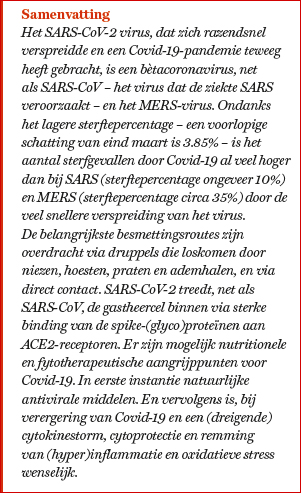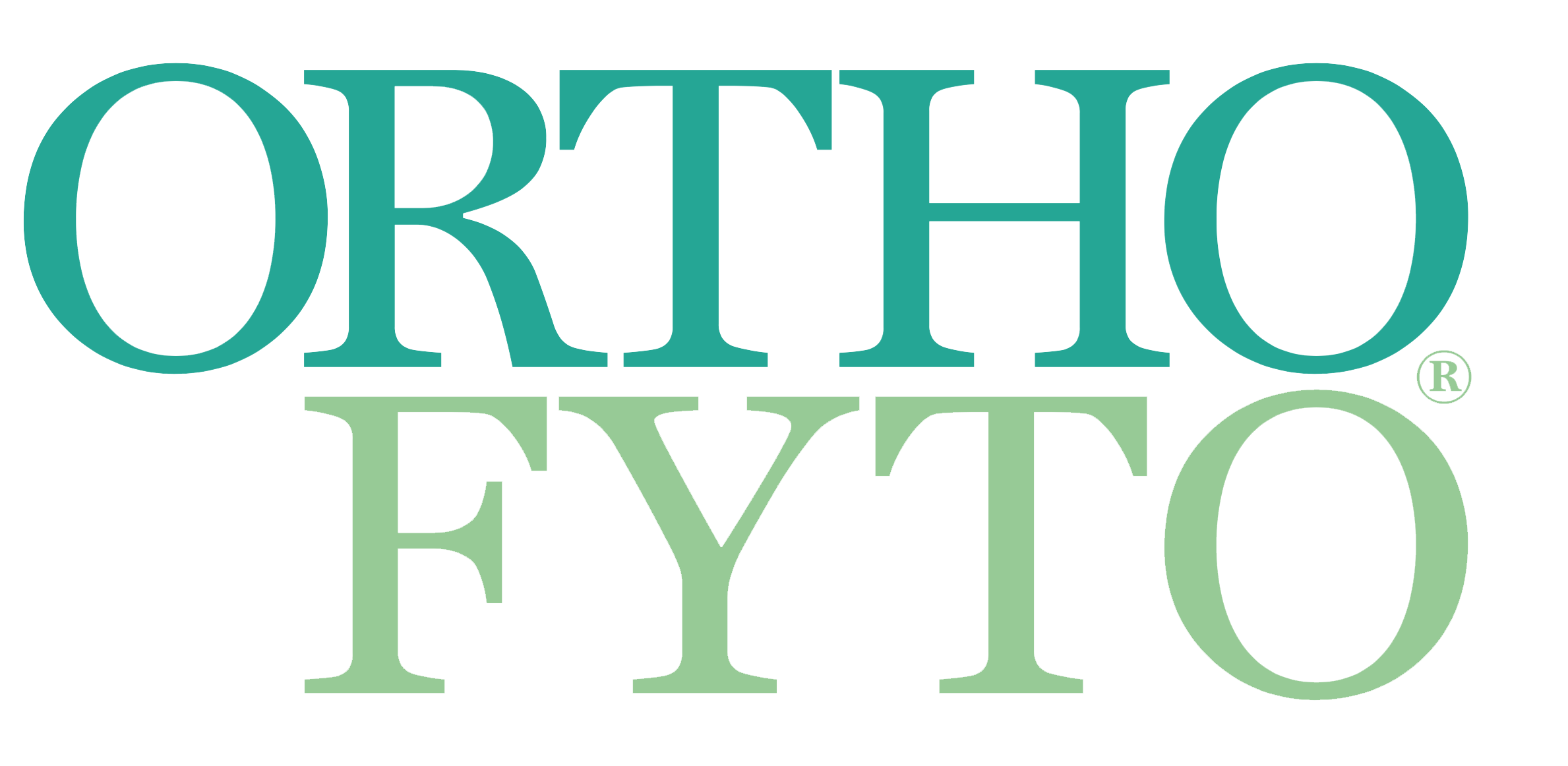Kenmerken van SARS-CoV-2 en de Covid-19-infectie
05 May, 2020
Door: Selma Timmer
 Corona-virus disease 2019, kortweg Covid-19, is de acute luchtwegaandoening, veroorzaakt door het nieuwe humane coronavirus SARS-CoV-2. Het heeft zich in goed twee maanden ontwikkeld tot een pandemie.1 Zonder straffe maatregelen kan zestig procent van de wereldbevolking besmet raken. In dit artikel worden natuurlijke antivirale middelen benoemd en nutriënten voor cytoprotectie.
Corona-virus disease 2019, kortweg Covid-19, is de acute luchtwegaandoening, veroorzaakt door het nieuwe humane coronavirus SARS-CoV-2. Het heeft zich in goed twee maanden ontwikkeld tot een pandemie.1 Zonder straffe maatregelen kan zestig procent van de wereldbevolking besmet raken. In dit artikel worden natuurlijke antivirale middelen benoemd en nutriënten voor cytoprotectie.
Sinds de eeuwwisseling is Covid-19, na SARS (severe acute respiratory syndrome) in 2002 en MERS (middle east respiratory syndrome) in 2012, de derde ernstige zoönose – een infectieziekte die van dier op mens overgaat – die door een coronavirus wordt veroorzaakt.2,3 Niet alle coronavirussen zijn gevaarlijk; vier laagpathogene humane coronavirussen veroorzaken sinds jaar en dag een vijfde van alle verkoudheden. Een coronavirus is herkenbaar aan de uitsteeksels (spike-proteïnen) die als een kroon (corona) uit het celmembraan steken.
SARS-CoV-2, in eerste instantie 2019-nCoV (2019 novel coronavirus) genoemd, is een bèta-coronavirus: een enkelstrengs RNA-virus in een proteïne-envelop, subgenus Sarbecovirus, subfamilie Orthocoronavirinae, familie Coronaviridae. Waarschijnlijk is deze variant afkomstig van vleermuizen.3 Ondanks het lagere sterftepercentage – een voorlopige schatting dd. 30 maart is 3.85%4 – is het aantal sterfgevallen door Covid-19 al veel hoger dan bij SARS (sterftepercentage circa 10%) en MERS (sterftepercentage circa 35%). Dat komt door de veel snellere verspreiding van het virus.2,5 Onderzoekers van het Erasmus MC in Rotterdam denken dat dit mede het gevolg is van gemakkelijke vermenigvuldiging van SARS-CoV-2 in de neus, terwijl het SARS- en MERS-virus voornamelijk dieper in de luchtwegen vermeerderen.
De belangrijkste besmettingsroutes zijn overdracht via druppels die loskomen door niezen, hoesten, praten en ademhalen, en via direct contact.3 SARS-CoV-2 is ook aangetoond in bloed en ontlasting van ernstig zieke coronapatiënten.3 Het coronavirus kan worden overdragen door mensen die nog niet ziek zijn en mogelijk ook door mensen die helemaal geen klachten krijgen na besmetting.6 Het nieuwe coronavirus kan enige dagen overleven op verschillende materialen; in hoeverre mensen na aanraking (en vervolgens aanraking van ogen, neus of mond) besmet raken is onduidelijk.
- Haagmans BL et al. Nieuw van de markt? Coronavirusuitbraak in Wuhan. Ned Tijdschr Geneeskd 2020;164:D4847.
- Guarner J. Three emerging coronaviruses in two decades, the story of SARS, MERS, and now COVID-19. Am J Clin Pathol. 2020;153(4):420-421.
- Guo YR et al. The origin, transmission and clinical therapies on coronavirus disease 2019 (COVID-19) outbreak – an update on the status. Mil Med Res. 2020;7:11.
- Lipsitch M. Estimating case fatality rates of COVID-19. Lancet Infect Dis. 2020
- Zhu N et al. A novel coronavirus from patients with pneumonia in China, 2019. N Engl J Med. 2020;382(8):727-733.
- Yu X et al. COVID-19 transmission through asymptomatic carriers is a challenge to containment. Influenza Other Respir Viruses. 2020 Apr 4.
- Wan Y et al. Receptor recognition by the novel coronavirus from Wuhan: an analysis based on decade-long structural studies of SARS coronavirus. J Virol. 2020 Mar 17;94(7).
- Abassi ZA et al. Covid-19infection and mortality - a physiologist's perspective enlightening clinical features and plausible interventional strategies. Am J Physiol Lung Cell Mol Physiol. 2020 Mar 24.
- Williams AE. Immunity to viruses. In: Immunology, mucosal and body surface defences. Wiley-Blackwell, 2012:217-237.
- CDC Centers for Disease Control and Prevention. Interim clinical guidance for management of patients with confirmed coronavirus disease (COVID-19).
- Report of the WHO-China Joint Mission on Coronavirus Disease 2019 (COVID-19), 16-24 February 2020.
- Lechien JR et al. Olfactory and gustatory dysfunctions as a clinical presentation of mild-to-moderate forms of the coronavirus disease (COVID-19): a multicenter European study. Eur Arch Otorhinolaryngol. 2020 Apr 6.
- Shi Y et al. COVID-19infection: the perspectives on immune responses. Cell Death & Differentiation, 10 March 2020.
- Zhao J et al. Antibody responses to SARS-CoV-2 in patients of novel coronavirus disease 2019. Clinical Infectious Diseases, 28 March 2020.
- Zhang L et al. Potential interventions for novel coronavirus in China: a systematic review. J Med Virol. 2020;92:479-490.
- Read SA et al. The role of zinc in antiviral immunity. Adv Nutr 2019;10(4):696-710.
- Thevarajan I et al. Breadth of concomitant immune responses prior to patient recovery: a case report of non-severe COVID-19. Nat Med. 2020;26:453-455.
- Harapan H et al. Coronavirus disease 2019 (COVID-19): a literature review. Journal of Infection and Public Health, 29 March 2020.
- Channappanavar R et al. Pathogenic human coronavirus infections: causes and consequences of cytokine storm and immunopathology. Semin Immunopathol. 2017;39:529-539.
- Gombart AE et al. A review of micronutrients and the immune system - working in harmony to reduce the risk of infection. Nutrients. 2020;12:236.
- Maggini S et al. Immune function and micronutrient requirements change over the life course. Nutrients. 2018;10(10):1531.
- Kakodkar P et al. A comprehensive literature review on the clinical presentation, and management of the pandemic coronavirus disease 2019 (COVID-19). Cureus April 06, 2020;12(4):e7560.
- Zhang L et al. Potential interventions for novel coronavirus in China: a systematic review. J Med Virol. 2020;92:479-490.
- Grant WB et al. Evidence that vitamin D supplementation could reduce risk of influenza and COVID-19infections and deaths. Nutrients. 2020;12:988.
- Bonafè M et al. Inflamm-aging: why older men are the most susceptible to SARS-Cov-2 complicated outcomes. Preprints 9 April 2020; 2020040143.
- Fulop T et al. Handbook on immunosenescence, basic understanding and clinical applications. Springer, 2009.
- Zuo L et al. Inflammaging and oxidative stress in human diseases: from molecular mechanisms to novel treatments. Int J Mol Sci. 2019;20:4472.
- Capuron L et al. Vitamin E status and quality of life in the elderly: influence of inflammatory processes. Br J Nutr. 2009;102(10):1390-4.
- Pae M et al. The role of nutrition in enhancing immunity in aging. Aging Dis. 2012;3(1):91-129.
- Wu D et al. Age-associated changes in immune function: impact of vitamin E intervention and the underlying mechanisms. Endocr Metab Immune Disord Drug Targets. 2014;14(4):283-9.
- McCarty MF et al. Nutraceuticals have potential for boosting the type 1 interferon response to RNA viruses including influenza and coronavirus. Prog Cardiovasc Dis. 2020 Feb 12.
- Cinatl J. et al. Glycyrrhizin, an active component of liquorice roots, and replication of SARS-associated coronavirus. The Lancet 2003;361:2045-2046.
- Li H et al. Coronavirus disease 2019 (COVID-19): current status and future perspectives. International Journal of Antimicrobial Agents, 2020.
- Chen H et al. Potential natural compounds for preventing 2019-nCoV infection. Preprints 2020, 2020010358.
- te Velthuis AJ et al. Zn2+ inhibits coronavirus and arterivirus RNA polymerase activity in vitro and zinc ionophores block the replication of these viruses in cell culture. PLOS Pathog. 2010;6(11): e1001176.
- Alschuler L et al. Integrative considerations during the COVID-19pandemic. Explore (NY). 2020 Mar 26.
- Dabbagh-Bazarbachi H et al. Zinc ionophore activity of quercetin and epigallocatechin-gallate: from Hepa 1-6 cells to a liposome model. J Agric Food Chem. 2014;62(32):8085-93.
- Carr AC. A new clinical trial to test high-dose vitamin C in patients with COVID-19. Critical Care. 2020;24:133.
- Sordillo PP et al. Curcumin suppression of cytokine release and cytokine storm. A potential therapy for patients with Ebola and other severe viral infections. In Vivo. 2015;29(1):1-4.
- Lai KY et al. High-dose N-acetylcysteine therapy for novel H1N1 influenza pneumonia. Ann Intern Med. 2010;152(10):687-8.
- Liu Q et al. The cytokine storm of severe influenza and development of immunomodulatory therapy. Cell Mol Immunol. 2016;13(1):3-10.
- Zhang Q et al. N-acetylcysteine improves oxidative stress and inflammatory response in patients with community acquired pneumonia: A randomized controlled trial. Medicine (Baltimore). 2018;97(45):e13087.
- Körner A et al. Resolution of inflammation and sepsis survival are improved by dietary Ω-3 fatty acids. Cell Death Differ. 2018;25(2):421-431.
- Zhang R et al. COVID-19: melatonin as a potential adjuvant treatment. Life Sci. 2020 Mar 23;250:117583.
- Shneider A et al. Can Melatonin Reduce the Severity of COVID-19Pandemic? Preprints 9 April 2020, 2020040122.
- Sun Z et al. Protective mechanism of sulforaphane in Nrf2 and anti-lung injury in ARDS rabbits. Exp Ther Med. 2018;15(6):4911-4915.
- Heiss E et al. Nuclear factor kappa B is a molecular target for sulforaphane-mediated anti-inflammatory mechanisms. J Biol Chem. 2001;276(34):32008-15.
